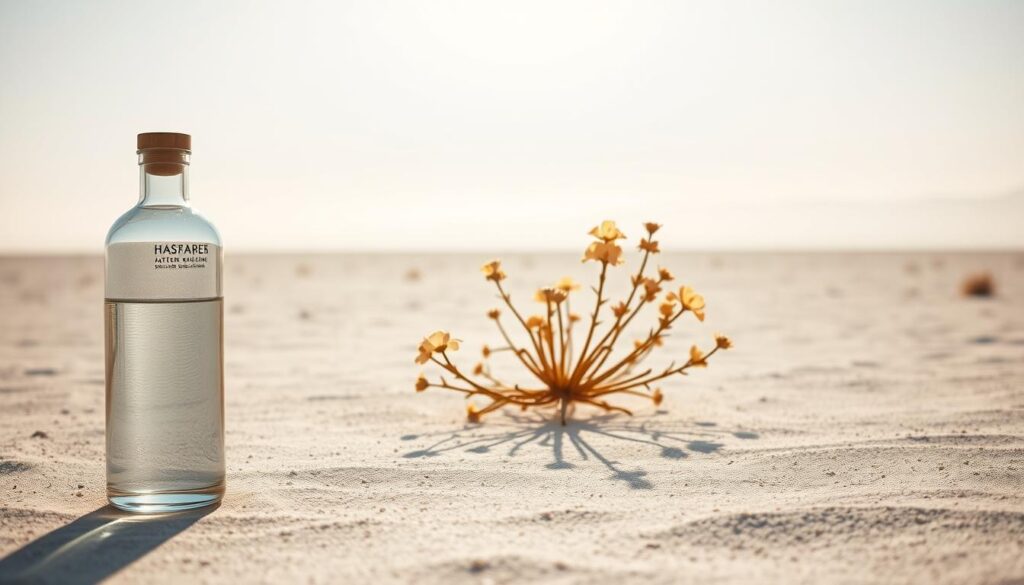Did you know that 70 to 80 percent of skincare and cosmetic formulas are made up of water? This means every time you use a traditional product, you’re mostly applying water to your skin1. With water scarcity affecting two-thirds of the world’s population, the beauty industry is shifting toward innovative solutions1.
Waterless beauty products are changing the game. By removing water from formulations, brands can create concentrated products packed with active ingredients. This approach not only boosts effectiveness but also reduces waste and packaging. Imagine a skincare routine that’s both powerful and kind to the planet.
Major players like L’Oreal and Unilever are already taking steps to reduce their water usage, signaling a broader industry trend1. These products often use oils, butters, and waxes, offering a longer-lasting and more sustainable alternative. The result? A beauty routine that’s efficient, eco-conscious, and impactful.
Key Takeaways
- Waterless beauty products are concentrated and more effective.
- They reduce water waste and packaging materials.
- Major brands are adopting this sustainable approach.
- Ingredients like oils and butters replace water in formulations.
- This trend is reshaping the beauty industry globally.
Understanding the Waterless Skincare Revolution
Innovative solutions are reshaping how we think about skincare. Traditional products often rely on water as a primary ingredient, diluting active components and reducing their effectiveness. In contrast, waterless formulations focus on concentrated ingredients like oils, waxes, and essential extracts. This approach not only enhances potency but also minimizes the need for preservatives.
What is Waterless Skincare?
Waterless skincare eliminates water from its formula, creating products that are richer in active ingredients. By removing water, brands can deliver more value in smaller amounts. This method also reduces the environmental footprint, as less packaging is required for concentrated formulas2.
These products often come in solid or powdered forms, which are easier to transport and store. This shift not only benefits the planet but also offers consumers a more efficient way to care for their skin.
Origins and Global Impact
The waterless skincare trend began in Seoul, South Korea, around 2015. Known for its innovative beauty practices, Seoul became a hub for this sustainable approach. The trend quickly spread globally, influencing brands and consumers alike.
By 2025, 1.8 billion people will live in areas affected by water scarcity, making water conservation a critical focus2. Waterless products help address this issue by reducing water use in both production and formulation. Additionally, they often come in eco-friendly packaging, further minimizing waste.
| Aspect | Traditional Skincare | Waterless Skincare |
|---|---|---|
| Primary Ingredient | Water | Oils, Waxes, Extracts |
| Potency | Diluted | Concentrated |
| Packaging | Plastic-heavy | Minimal, Eco-friendly |
| Environmental Impact | High | Low |
Consumer demand for sustainable options is rising, with many willing to pay more for products that align with their values2. Waterless skincare meets this demand, offering a smarter choice for both the skin and the planet.
Eco-Friendly Elegance: Why Waterless Skincare is the Future of Sustainable Beaut
Consumers are increasingly drawn to skincare solutions that deliver results while minimizing environmental harm. Waterless beauty products are at the forefront of this movement, offering concentrated formulas that work harder for your skin. By eliminating water, these products reduce waste and enhance efficacy, making them a smart choice for your routine.

Benefits and Enhanced Efficacy
Waterless skincare products pack a punch with higher concentrations of active ingredients. Without water to dilute the formula, each application delivers more value to your skin. This approach also reduces the need for preservatives, resulting in cleaner and gentler formulations3.
These products are less prone to microbial growth, ensuring they stay fresh longer. For example, brands like French Girl use botanical extracts and natural materials to create effective and eco-conscious solutions. This makes waterless skincare a powerful and sustainable alternative to traditional options.
Innovations in Formulation and Packaging
The beauty industry is embracing new techniques to reduce environmental impact. Waterless products often come in recyclable or reusable containers, cutting down on plastic waste3. Refillable packaging is also gaining traction, offering a practical way to reduce your footprint.
Formulations now include upcycled ingredients like coffee grounds and fruit peels, further minimizing waste. These innovations not only benefit the planet but also enhance the quality of your skincare routine. With lighter shipments and reduced carbon emissions, waterless beauty is a win-win for everyone4.
| Aspect | Traditional Skincare | Waterless Skincare |
|---|---|---|
| Active Ingredients | Diluted | Concentrated |
| Preservatives | High | Low |
| Packaging | Plastic-heavy | Eco-friendly |
| Environmental Impact | Significant | Minimal |
As consumer demand for sustainable options grows, waterless skincare is becoming a cornerstone of modern beauty. These products offer a smarter, more effective way to care for your skin while protecting the planet.
Impact on the Beauty Industry and Consumer Choices
The beauty industry is undergoing a transformation driven by sustainability and innovation. As global water scarcity becomes a pressing issue, brands are rethinking their practices to reduce their environmental footprint. This shift is not only reshaping production methods but also influencing consumer preferences.

Water Conservation and Environmental Benefits
Waterless formulations are a game-changer for conserving resources. By eliminating water from their products, brands can significantly reduce water usage in production. This approach also lowers energy consumption, as less water means fewer resources are needed for transportation and storage5.
Additionally, these formulations often require less packaging, cutting down on plastic waste. For example, L’Oréal has committed to reducing its water consumption by 60% by 2030, setting a benchmark for the industry5.
Market Trends and Sustainable Practices
Major beauty brands are leading the charge in adopting sustainable practices. Unilever, for instance, has introduced refillable packaging and waterless products to meet consumer demand for eco-friendly options5. This trend is gaining momentum, with 75% of beauty consumers expected to prefer sustainable brands by 20256.
Innovations like solid shampoos and conditioners are also on the rise, offering a practical solution to reduce waste. These products not only save water but also provide a longer-lasting alternative to traditional formulas.
Consumer Shifts and Global Sustainability Challenges
Consumers are increasingly prioritizing sustainability in their purchasing decisions. A recent study found that 65% of consumers want transparency in product ingredients and ethical practices from beauty brands6. This shift is driven by growing awareness of global water scarcity and environmental challenges.
Brands that align with these values are gaining traction. For example, French Girl uses botanical extracts and eco-friendly packaging to appeal to conscious consumers. This approach not only benefits the planet but also enhances brand loyalty.
| Aspect | Traditional Beauty | Waterless Beauty |
|---|---|---|
| Water Usage | High | Low |
| Packaging | Plastic-heavy | Minimal, Recyclable |
| Consumer Appeal | Standard | Eco-conscious |
| Environmental Impact | Significant | Minimal |
As the beauty industry evolves, your choices as a consumer can drive meaningful change. Opting for waterless products and supporting sustainable brands helps reduce your environmental impact while enhancing your beauty routine.
Conclusion
The shift toward concentrated beauty products is reshaping routines globally. By removing water from formulations, brands deliver more potent ingredients in smaller packages. This approach reduces waste and enhances the benefit of each product.
Major brands are leading this trend, offering innovative solutions like solid bars and refillable packaging. These changes not only save water but also cater to the growing need for sustainable practices7.
As a consumer, your choices matter. Opting for water-free beauty products supports global conservation efforts while improving your care routine. This future-focused approach ensures both your skin and the planet thrive.
FAQ
What is waterless skincare?
How does waterless skincare benefit the environment?
Are waterless skincare products more effective?
What are some common types of waterless skincare products?
How does waterless skincare align with sustainable practices?
What market trends are driving the popularity of waterless skincare?
How can I incorporate waterless skincare into my routine?
Source Links
- Why waterless beauty might just be the future of cosmetics – https://www.glamourmagazine.co.uk/gallery/waterless-beauty
- Waterless Skincare: Revolutionizing Beauty in 2025 – https://haleandbelle.com/waterless-skincare-transforming-the-future-of-sustainable-beauty-in-2025/
- Sustainable Beauty Trends: Shaping the Future of Skincare – https://trilipiderm.com/blogs/news/sustainable-beauty-trends?srsltid=AfmBOooPGPbQafeyXDSRIXYR00LrKFu7LxPU5Ctp-QpzsuvDoS4HWOhH
- 2025 Trend Report: Sustainable Solutions in the Beauty Industry – https://www.linkedin.com/pulse/2025-trend-report-sustainable-solutions-beauty-industry-qosmedix-7zsxe
- What is the Future of Beauty in 2025? Trends Every Professional Should – https://purespadirect.com/blogs/pure-spa-direct-blog/what-is-the-future-of-beauty-in-2025-trends-every-professional-should-know?srsltid=AfmBOop9ZjiK4E0ZH5XSOMcYG3ShMU4PSHVK-_5nRE-rouI9if7vBkzQ
- April INSIDER INSIGHTS: in-cosmetics Global 2024 Ingredient Launches + Packaging for Beauty – https://www.gcimagazine.com/ingredients/launches-claims/article/22887597/april-insider-insights-incosmetics-global-2024-ingredient-launches-packaging-for-beauty
- Formulating on Trend: Waterless Cosmetics – https://www.cosmeticsandtoiletries.com/formulas-products/skin-care/article/21835650/sun-chemical-formulating-on-trend-waterless-cosmetics




